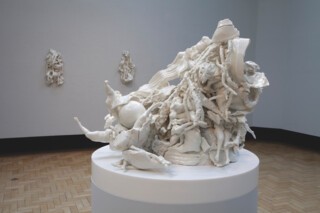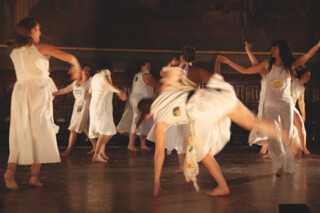In Rochdale
Marina Warner
Whiteness is the colour of mourning for many Indians and Indonesians and in other cultures besides; ash at the end of a cycle of destruction can also turn white; the pallor of celery or asparagus in France is caused by growing it buried in darkness. The full spectrum of visible light glows white – white also conveys purity, radiance and lightness in both senses, luminous and weightless. The dancers in the corps de ballet of a Romantic ballet usually wear white, powder-puff tutus or shimmering longer layers of ethereal white tulle (and let’s not speak of wedding dresses). One of the most intense chapters of Moby-Dick hymns ‘the whiteness of the whale’, the creature’s spectral sublime.
Working with porcelain, the artist Rachel Kneebone makes whiteness reverberate to the depths. Shining, delicate and visceral, transcendent and perturbing, her work looks back to origins and forward to ends. She has quoted Georges Bataille in relation to what she makes: ‘The smoothness, the tumescence, the milky flow of feminine nudity anticipate a sensation of liquid outpour, which itself opens onto death like a window onto a courtyard.’
Kneebone likes to let the extreme conditions inside the kiln act on her artefacts, exulting in the ways the intense heat bends and folds the clay, her forms’ limbs and hollows buckling and slipping, cracking and tumbling. The compositions she creates suggest intertwined limbs, human bodies doing bodily things in a perspective of eternity: times of bliss, times of torment; erotic commingling, and seething stuff in witches’ cauldrons. Dante’s Inferno, as illustrated by Botticelli, and Rodin’sGates of Hell are invoked, as in 399 Days, a vortex five metres high, on show at the Victoria and Albert Museum since last year (till 2021).
She mixes in recurring emblems – roses, tendrils, ribbons, bare feet, kicking legs – and they stir memories of festivity and luxury from the repertoire of rococo hedonism; she often also poises in a tangle of forms a perfect orb, a bubble hinting at mortality. Her sculptures are ambitious large-scale works, each one an intricate intersheaved mass, held together by the glistening pale flesh of the china surfaces and punctuated by the modelling of fragile detail – a toe here, a banderole there.
Ali Smith has written about Kneebone’s work, a marvellous flight of an essay in which she invokes the Latin word os, meaning both ‘bone’ and ‘mouth’, as she explores the orifices and slashes in the sculptures. She senses in them an urgency about speaking of women – of our bodies, our experiences, our lives – and exults that it does not convey despair. Instead, she feels in it ‘this kick of the lifeforce … I’m almost tempted to call it cheerful.’
A sequence of new sculptures was exhibited in the gallery at Touchstones in Rochdale, a public arts centre in the former library, a splendid arts and crafts building. Like Bernini’s and Rodin’s, Kneebone’s work conveys dynamic movement even in the stillness of the porcelain, and was made with dance in mind: the opening room, under a stained-glass dome, displayed on its own a sculpture called What is remembered in the body is well remembered, the title quoting Elaine Scarry’s study The Body in Pain. It set the mood for the works that followed: Balance, Stretch, Bend, Streak, Step, Skim, Roll, Whirl, Twitch. As Merce Cunningham wrote of his ideal of dance, Kneebone’s sculpture expresses ‘the possibility of containment and explosion being instantaneous’. Trying to take in the shifting rhythmic forms of the pieces, your eyes dance over and into their promontories and crannies while your body dips and cranes to see into their intricacies and relations.
Kneebone always envisaged a dance piece in response to the sculpture, and wanted to work with local women. Once a prosperous mill town, as its grand municipal buildings show, Rochdale now suffers from all the problems of today’s Britain and the growing poverty of so many, especially women and children. The choreographer T.C. Howard recruited a group of women living in the town; they included every kind of refugee, from wars overseas and from violence and disasters at home.
The first performance (which I saw only on Vimeo) was held in the Town Hall, a triumph of Victorian Gothic, encrusted with stained glass, mullions and panelling, and richly painted with historical legends, all built in the heyday of Rochdale money. For all the distance of the shots and the fuzzy sound, from the first instant the dancers’ involvement was compelling in its intensity and grace. Among the large cast were three or four professional dancers, but none of the others had ever danced before. They made a corps de ballet of all shapes and sizes, ages and origins, and over a sequence of enigmatic tableaux, they forged a profound alliance between themselves. The music by Colin Elliot – some of it played live on the cello – heightened the sense of contained, explosive emotion.
The second performance took place in the galleries on the closing day of the show. This time I could go. Howard and the dancers adapted it to fit the different spaces, and again, from the moment the women appeared, a mood was commandingly established. The group was smaller, one was pregnant, another was with her baby daughter, and they made a potent chorus, dressed in white with lace trimmings and embroidered mottoes: one said ‘Keeping the Black Dog at Bay’, another ‘New Chapter’. They had also pinned on mementoes: a nappy pin, photos of their children. Their reciprocal gestures and ritualistic sequences of moves evoked the sculptures: the dancers sprinkled white powder on the ground and printed it with their bare feet, they came together and moved apart, they caught their breath, they interlinked with one another in duets and trios and circles, they stroked and held and balanced one another, they wrung their hair, one of them recited a poem, with the line ‘I’m sure I could walk on water like this’; at the close they all walked away leaving one woman standing heroically alone.
They conveyed a sense of discoveries about themselves and others, and of finding strength in the process, and they drew the audience in, made us part of what they were communicating, which was a kind of grief and a kind of defiance, a secular version of ‘heaven in ordinary … something understood’ between them and with us.
In Heaven on Earth, T.J. Clark puzzles over the picturing of transcendence in religious paintings that hold him enthralled. A Marxist realist who has mined the interactions of images and social conditions, he interrogates himself relentlessly in the book about his attraction to Giotto’s vision of a divine messenger aloft, or scenes of sacred ritual by Poussin, and he suggests that these artists, making pictures of what is not there to see or touch (angels, sacraments), convey ‘their deepest thoughts about attending – looking, reflecting, participating, being present or absent; that is, being inside or outside the sphere of action or belief’. It is through their intense absorption in ‘the here and now’, their grounded, embodied forms and use of rich mineral colour, that they can intimate the ‘wordless, the un-figured, the faceless’ dimensions of what we can only guess at.
I come from a background of intense Catholicism, unlike Clark, but when I fall under the spell of a Catholic painting, I share his sense of dividedness, between emotion and intellect, in a way I don’t if the image is a Buddha. Clark’s arguments are subtle, and they help to illuminate the new sacred in secular contemporary art; dance, being a wordless drama of mood shifts and enigmatically changing relationships, supports Clark’s hypothesis more closely even than narrative sequences such as Giotto’s in the Arena Chapel.
It is easy to be sceptical of community arts, to resist the call of do-gooders and therapists and hold yourself at a distance from such activity. I have seen smart Manhattanites look on ironically when Pierre Huyghe devised a foundation day pageant, complete with a myth of origin (made up), a moon balloon, and a local anthem for the newly arrived inhabitants of a low-priced, half-built housing development on the Hudson.
The Rochdale Dance Project wasn’t like that. Rather, it showed what an artist can inspire and what arts can do. An earlier sculpture of Kneebone’s is called Emerging out of an inconceivable void into the play of beings (also from Bataille), and this is what she and Howard and the women of Rochdale achieved – intimations of meaningfulness, a sculpture in motion, bodies in action against negation. It mattered that the bodies were ‘ordinary’: realism in the midst of otherworldly hopes and dreams.
There was no press; pretty much nobody outside Rochdale bothered to go. But the women say their group will continue to dance and to dance together.


Comments